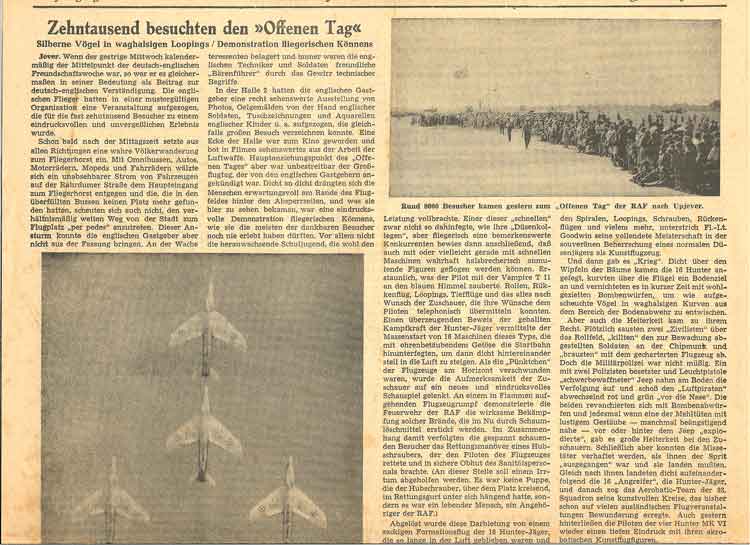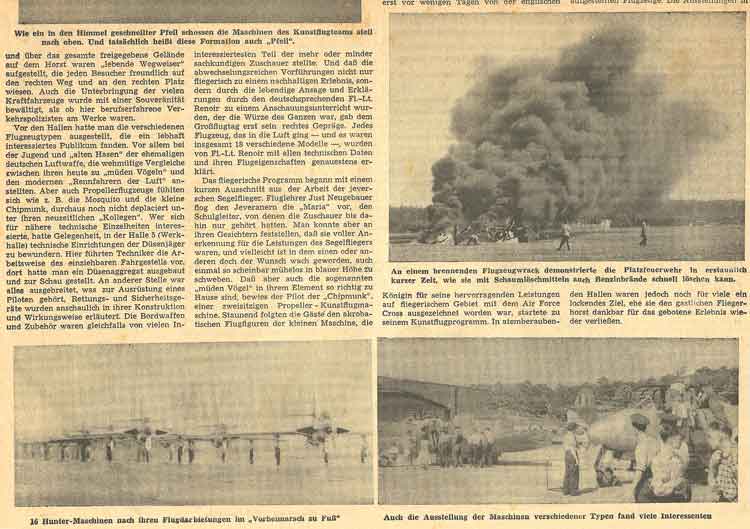

| ||
|
Front Page Jeversches Wochenblatt 164 Jahrgang No. 140 dated Thursday the 20 June 1957 Translated by Maurice Parker Picture Captions Top Right: Around 8,000 visitors came to Upjever yesterday for the RAF Open Day. Middle left: The aerobatic team climb steeply like an arrow shot swiftly in to the sky. This formation really is called an 'arrow'. Middle right: The Fire Section demonstrate on a blazing aircraft wreckage how in an astonishingly short time a petrol fire can be extinguished with the use of foam. Bottom Left: 16 Hunter aircraft after their flying display in a 'march-past on foot'. Bottom Right: The static display of different aircraft types was of interest to many of the visitors. Ten Thousand Visit the Open Day Silver Birds in reckless loops/Demonstration of Flying Talent. Jever. If yesterday was, according to the calendar, the middle of the German-British Friendship Week then at the same time it is in meaning a contribution to the German-British understanding. The British airmen had extremely well organised this sensational event which for the ten thousand visitors turned out to be impressive and unforgettable. Shortly after mid-day a regular migration of people started in the direction of the airfield. By bus, car, motorcycle, moped and bicycle in a difficult to foresee flow of traffic on the Rahrdumer Strasse to the main gate of the station. Those people who could find no room in the overfilled buses did not hesitate to walk the relatively long way from town to the station. This rush of people however could not upset the British hosts. At the main gate and all over the permitted areas of the airfield 'living sign-posts' were present to friendly direct the visitors the right way to the right area. The parking of the many vehicles was also mastered without difficulty as if experienced traffic control police were at work. In front of the hangars various aircraft types were on display which had found lively interest with the public. Above all the young people and also previous members of the German Luftwaffe who nostalgically compared their present day 'tired birds' to the now modern racing car drivers of the air. Even the propeller driven aircraft such as the Mosquito and the small Chipmunk did by no means feel out of place under their modern counterparts. Those people who took an interest in the technical details had their chance to do so in Hangar 5 (Tech Wing) where the components and equipment of a jet fighter could be seen. It was here that technicians demonstrated the function of a retractable undercarriage and a removed jet engine was on display. Spread out in another part of the hangar one could see what belonged to a pilot's equipment together with rescue and safety equipment, whereby the operation and design were clearly explained. The aircraft weapon systems and additional components were also besieged by visitors, here the British technicians and airmen were always prepared to explain the technical terms in a friendly way. Hangar 2 was also well visited where the British hosts presented a really worth seeing exhibition of photos and oil paintings created by British servicemen and also ink drawings and water colour paintings made by British children. One corner of the hangar was turned into a cinema which showed films on interesting aspects of air force life. Without a doubt the largest attraction of the Open Day was the large flying display that had been previously announced by the British hosts. The visitors thronged the cordoned off area on the edge of the taxi-way and what they were able to see was an impressive demonstration of flying skill which most of the thankful spectators had never experienced before. Above all the young school boys who made up the most interested part of the more or less competent spectators. The various flying demonstrations were not only a lasting experience but with the lively announcements and explanations made by the German speaking Flt/Lt Renoir added the spice to the whole flying demonstration. Every aircraft that took-off - which totalled 18 different types - Flt/Lt Renoir explained in detail the technical data and flight features. The flying programme commenced with a short glimpse into the work of the Jever Gliding Club where Flying Instructor Just Neugebauer flew the training glider 'Maria' in front of the Jever population and which up until now the spectators had only heard about One could see in their faces that they fully appreciated the achievements of the glider pilots and possibly one or other of them also had the wish to once soar apparently effortlessly in the blue altitudes. That the so called 'tired bird' is really at home in its elements proved the pilot of the Chipmunk, a propeller driven 2 seater aerobatic aircraft. The spectators followed with astonishment the aerobatic figures made by this small aircraft which fulfilled all its achievements. One of these 'speedy', but not high speed like its 'jet colleagues', but however in flying ability a noteworthy rival proved finally that even a fast aircraft can genuinely carry out perilous but gracefully flown figures. It was amazing what the pilot of the Vampire T.11 performed in the blue sky. Rolls, loops, inverted flight and low flying and that all at the request of the spectators who could pass on their wish to the pilot via radio. A convincing proof of the concentrated fighting power of the Hunter fighter provided the mass start of 16 aircraft of this type which with ear-splitting noise took-off down the runway and one after the other steeply climbed into the air. As the aircraft disappeared in the horizon the attention of the spectators focused on a new and impressive spectacle. On an aircraft fuselage that was on fire, the RAF Fire Section demonstrated an effective fighting of such fires which in a very short time was put out with the aid of foam. Following this action the anxiously watching spectators could follow the rescue operation made by the helicopter which saved the pilot of the aircraft and safely handed him over to the medical services. (At this point a mis-understanding must be put straight. It was not a dummy that the helicopter had hanging in the life-belt slung underneath when flying circles over the airfield but a living person, a member of the RAF). This demonstration was replaced by a smart formation of 16 Hunter fighters which had remained in the air and which everybody had tensely waited for. Flt/Lt Ken Goodwin, who only a few days ago was awarded the Air Force Cross by H.M. the Queen for outstanding achievements in the sphere of aviation, started his aerobatic programme. In breathtaking spirals, loops, rolls, inverted flights and much more Flt/Lt Goodwin underlined his complete mastery in the supreme control of a normal jet fighter as an aerobatic aircraft. After this performance was over, flying very low over the top of the trees came 16 Hunters, banked over a ground target and destroyed this in a very short time with well placed bombs before finally, like frightened birds, recklessly weaving away out of range of the ground defences. The fun side of things did not come too short as all of a sudden 2 'civilians' dashed over the runway and 'knocked out' the airmen guarding the Chipmunk and finally taking to the air in the captured plane. The military police were however not inactive. A jeep with 2 military policemen and heavily armed with signal pistols followed the pirates on the ground alternately firing red and green flares 'across the bows'. Both pirates took their revenge by dropping bombs and every time a flour-bag 'exploded' in a cloud - sometimes alarmingly close - in front or behind the jeep, the spectators enjoyed this very much. Finally both evil-doers were able to be arrested when they had to land due to a shortage of fuel. Once the Chipmunk had landed the 16 attacking Hunter fighters followed each other in a close stream. This was followed by the 93 Squadron Aerobatic Team flying artistic circles which up until now had caused much enjoyment at many foreign air shows. Yesterday the pilots of the 4 Hunter Vis also left behind a deep impression with their aerobatic formations. The striking finale of the Air Day was made by the starts and fly-past of all aircraft on static display. The exhibitions in the hangars were however for many an attraction before they thankfully departed the event and the hospitable airfield. (Thanks to Bruno Albers for the cutting and Maurice Parker for the translation.) |
||